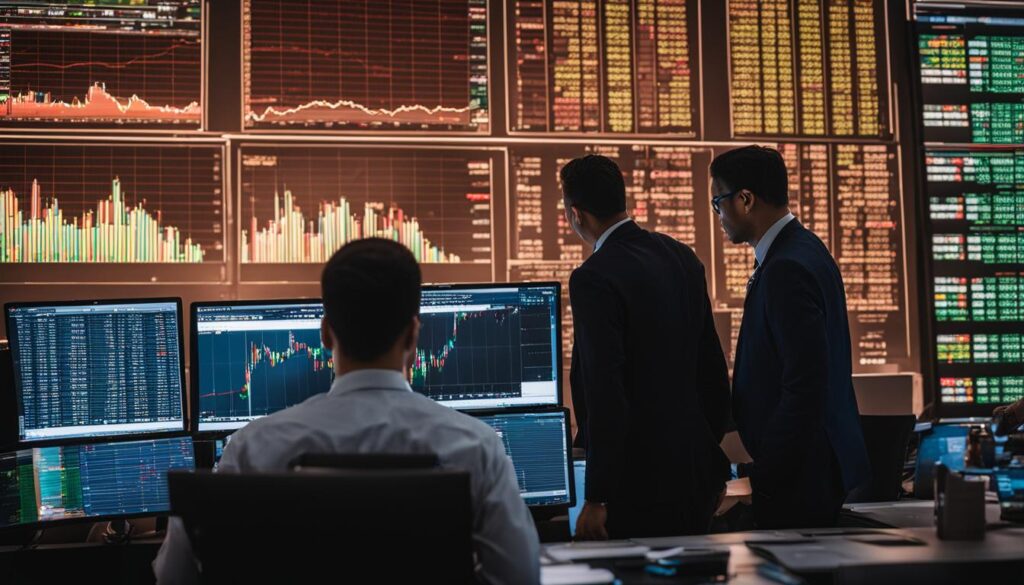In the world of financial markets, futures trading plays a significant role. As an investor, it’s crucial to understand how futures contracts work and the specifications that govern them. By gaining a clear understanding of futures contracts specifications, you can navigate the complexities of this form of trading with confidence and make informed investment decisions.
Futures contracts are a type of derivative trading that involve buying or selling contracts for an underlying asset at a predetermined price and date in the future. They provide traders with a way to speculate on the future price movements of assets such as commodities, currencies, and financial instruments.
To effectively engage in futures trading, it’s important to familiarize yourself with the different types of futures contracts available. These include commodity futures, financial futures, and currency futures. Each type has its own unique set of characteristics and factors that influence their prices.
Additionally, understanding the concept of margin and leverage is vital in futures trading. Margin refers to the initial deposit that traders must provide to open a futures position. It acts as collateral and allows traders to control larger positions with the help of leverage, which involves borrowing money to amplify potential gains or losses.
By delving into the details of futures contracts, traders can develop a comprehensive risk management strategy. This involves identifying contract specifications, such as contract size, tick size, and contract expiration dates, as well as considering settlement methods and market analysis techniques.
In this article, I will explore the various aspects of futures contracts specifications and their significance in successful futures trading. Together, we will decode the intricacies of futures trading and equip you with the knowledge needed to participate intelligently in this dynamic market.
Key Takeaways:
- Understanding futures contracts specifications is crucial for successful futures trading.
- Futures contracts involve buying or selling contracts for an underlying asset at a predetermined price and date in the future.
- There are different types of futures contracts, including commodity futures, financial futures, and currency futures.
- Margin and leverage play a significant role in futures trading and require careful consideration.
- A comprehensive risk management strategy is essential to navigate the complexities of futures trading.
The Barings Bank Collapse: Lessons for Futures Traders
The collapse of Barings bank in 1995 serves as a cautionary tale for futures traders, providing valuable lessons on the risks and rewards of futures trading. This catastrophic event was caused by the fraudulent practices of futures trader Nick Leeson, which ultimately led to the bank’s downfall.
Leeson’s trading activities involved futures contracts linked to the Nikkei 225 index. Unfortunately, when the Kobe earthquake struck in 1995, the index plummeted, resulting in significant losses for Barings bank and Leeson himself.
To cover up his mounting losses, Leeson resorted to fraudulent practices, such as creating a fictitious account and engaging in fake trades. These deceptive actions served as a stark reminder of the importance of transparency and ethical conduct in futures trading.
“The collapse of Barings bank highlighted the crucial need for proper risk management and oversight in the futures trading industry. It serves as a wake-up call for traders to remain vigilant and adhere to the highest standards of integrity.”
Futures trading inherently involves risks, but the Barings bank collapse exposed the devastating consequences when these risks are not properly managed. It serves as a reminder that traders must exercise caution, thoroughly understand the market dynamics, and implement robust risk management strategies.
By learning from the mistakes made during the Barings bank collapse, futures traders can gain valuable insights and take proactive measures to protect themselves and their investments.
| Lessons Learned from the Barings Bank Collapse |
|---|
| Importance of proper risk management |
| Need for transparent and ethical conduct |
| Understand market dynamics |
| Implement robust risk management strategies |
Understanding Futures Trading: Basics and Concepts
Futures trading is a fascinating and dynamic market that involves buying or selling contracts for an underlying asset at a predetermined price and date in the future. It offers traders the opportunity to profit from price fluctuations in a range of assets, including commodities, financial instruments, and currencies. To navigate this market successfully, it is essential to have a solid understanding of the basics and key concepts involved.
Futures Contracts: Types and Characteristics
There are different types of futures contracts, each designed to cater to specific asset classes and objectives. Commodity futures contracts allow traders to speculate or hedge their positions in commodities like gold, oil, or wheat. Financial futures contracts revolve around assets such as stock indexes, interest rates, or government bonds. Currency futures contracts involve trading currencies in anticipation of fluctuations in exchange rates.
To illustrate the diverse range of futures contracts, let’s take a deeper look at one example – commodity futures. This form of trading is particularly popular among farmers, manufacturers, and speculators. For instance, a corn farmer can use commodity futures contracts to lock in a favorable price for their crop before the harvest. On the other hand, manufacturers can use these contracts to hedge against future price increases in raw materials.
Understanding the specifications of futures contracts is essential when engaging in futures trading. Specifications outline the contract size, delivery months, tick size (minimum price movement), and the underlying asset. For example, the contract size for gold futures traded on the Chicago Mercantile Exchange (CME) is 100 troy ounces. Each tick represents a minimum price movement of $0.10 per ounce.
Margin and Leverage: Enhancing Trading Potential
One of the key aspects of futures trading is the concept of margin and leverage. Traders are required to deposit a margin, acting as collateral, when entering into futures positions. Unlike other financial markets, futures trading allows for significant leverage, meaning traders can control larger positions with a smaller initial investment.
By leveraging their capital, traders can potentially amplify their profits. However, it is crucial to remember that leverage can also magnify losses. Therefore, proper risk management and understanding the potential downside are imperative when utilizing leverage in futures trading.
Margin requirements vary depending on the underlying asset and exchange regulations. Generally, lower-risk assets such as government bonds require lower margins, while higher-risk assets necessitate larger margins. Margin calls may occur if the trade moves against the trader, requiring additional funds to maintain the position.
Key Considerations for Successful Futures Trading
Successful futures trading requires a comprehensive understanding of various elements. Apart from comprehending futures contract specifications and leveraging margin effectively, traders need to develop a sound trading strategy. This involves thorough market analysis, including technical and fundamental analysis, to identify potential trading opportunities.
In addition, keeping an eye on global events, economic indicators, and geopolitical developments can significantly impact futures markets and therefore require attention. Staying up-to-date with these factors can help traders make informed decisions and react swiftly to market changes.
A Complete Overview of Contracts Specifications
| Asset Class | Exchange | Contract Size | Delivery Months | Tick Size |
|---|---|---|---|---|
| Gold Futures | Chicago Mercantile Exchange (CME) | 100 troy ounces | February, April, June, August, October, December | $0.10 per ounce |
| Crude Oil Futures | New York Mercantile Exchange (NYMEX) | 1,000 barrels | January, February, March, April, May, June, July, August, September, October, November, December | $0.01 per barrel |
| E-mini S&P 500 Futures | Chicago Mercantile Exchange (CME) | $50 x S&P 500 index | Four nearest serial months | $0.25 index point |
It is essential to study and comprehend the specifications of the specific futures contracts traders wish to engage in. This knowledge empowers traders to make informed decisions, manage risk effectively, and capitalize on potential opportunities in the futures market.
Trading Futures vs Trading Stocks: Key Differences and Similarities
When it comes to investing and trading, two prominent options are trading futures and trading stocks. While both offer potential opportunities for profit, there are distinct differences and similarities between the two.
Trading Futures: In futures trading, individuals buy or sell contracts for an underlying asset. These assets can include commodities, currencies, or financial instruments. Traders enter into an agreement to buy or sell the asset at a specific price on a future date. The contracts are standardized and traded on regulated exchanges.
Trading Stocks: On the other hand, stock trading involves buying and selling shares of publicly listed companies. Investors can own a portion of the company by buying shares, and they profit when the stock price increases or receive dividends based on the company’s performance.
While there are similarities between trading futures and trading stocks, such as the potential for profit and the opportunity to diversify portfolios, there are also notable differences:
- Risk and Leverage: Futures trading involves leverage, which allows traders to control larger positions with a smaller upfront investment. This also means that losses can be magnified. In contrast, stock trading does not typically involve leverage, and traders only risk the amount they invest.
- Market Structure: Futures trading takes place on regulated exchanges, where contracts are standardized and traded openly. Stock markets, on the other hand, consist of various exchanges where stocks are traded in a decentralized manner.
- Asset Class: Trading futures allows individuals to gain exposure to different asset classes, including commodities like gold or oil, currencies, and financial instruments. Stock trading focuses specifically on shares of publicly listed companies.
It is important for individuals to understand the specific characteristics and risks associated with each type of trading before deciding which path to pursue. Traders interested in commodities, currencies, or financial instruments may find futures trading more suitable, while those who prefer investing in individual companies may lean towards stock trading.
Ultimately, successful trading in either futures or stocks requires a comprehensive understanding of the market, careful analysis, and effective risk management.
Conclusion: The Importance of Understanding Futures Contracts Specifications
Understanding futures contracts specifications is crucial for anyone involved in futures trading. The complexity and risk associated with futures trading can be daunting, but with the right knowledge and risk management strategies, it can also offer a profitable investment opportunity.
By having a thorough understanding of the various types of futures contracts, leverage, margin requirements, and contract specifications, traders can make informed decisions and effectively manage their risk. Diligent research, staying up-to-date with market trends, and ongoing education are key to success in the futures trading market.
Proper risk management is essential to protect against potential losses in futures trading. Traders should develop a solid risk management plan, which includes setting stop-loss orders, diversifying their portfolio, and closely monitoring market conditions.
Ultimately, futures trading can provide opportunities for financial growth and diversification, but it requires a disciplined and informed approach. By understanding the intricacies of futures contracts and implementing effective risk management strategies, traders can navigate the market with confidence and improve their chances of success.
FAQ
What is futures trading?
Futures trading is a type of derivative trading that involves buying or selling contracts for an underlying asset at a predetermined price and date in the future.
What are the main types of futures contracts?
The main types of futures contracts are commodity futures, financial futures, and currency futures.
Who uses futures trading and for what purposes?
Futures trading is used by farmers, manufacturers, investors, and speculators for various purposes, including hedging, diversification, and speculation.
Is futures trading risky?
Futures trading can be highly risky but also highly rewarding, so it’s important to understand the risks and rewards before getting involved.
What was the Barings Bank collapse and how does it relate to futures trading?
The Barings Bank collapse in 1995 was caused by futures trader Nick Leeson’s fraudulent practices. He traded futures contracts linked to the Nikkei 225 index and incurred significant losses when the index plummeted due to the Kobe earthquake.
What fraudulent practices did Nick Leeson engage in?
Nick Leeson engaged in fraudulent practices to hide his losses, creating a fictitious account and engaging in fake trades.
What did the collapse of Barings Bank highlight about futures trading?
The collapse of Barings Bank highlighted the importance of proper risk management and oversight in futures trading.
What are the key characteristics of futures trading?
Futures trading involves buying or selling contracts for an underlying asset at a predetermined price and date in the future. It requires traders to deposit a margin, which acts as collateral, and allows for leverage, or borrowing money to control larger positions.
How can I be successful in futures trading?
To be successful in futures trading, it is crucial to understand contract specifications, settlement methods, and market analysis. Ongoing education and staying up-to-date with market trends are also key.
What are the differences between futures trading and stock trading?
Futures trading involves buying or selling contracts for an underlying asset, while stock trading involves buying or selling shares of companies. Both offer the potential for profit, but futures trading involves leverage and higher risk.
Why is it important to understand futures contract specifications?
Understanding futures contract specifications is crucial for anyone involved in futures trading to make informed decisions and manage their risk effectively.
Is futures trading a complex and risky endeavor?
Yes, futures trading can be a complex and risky endeavor, but with the right knowledge and risk management strategies, it can also be a profitable investment opportunity.
Source Links
- https://fastercapital.com/content/Futures-trading–Decoding-Futures-Trading–Insights-from-Nick-Leeson.html
- https://fastercapital.com/content/Futures–The-Art-of-Trading-Futures–Decoding-Financial-Instruments.html
- https://atas.net/market-theory/what-futures-and-a-futures-contract-are/
Disclaimer
All information on this website is of a general nature. The information is not adapted to conditions that are specific to your person or entity. The information provided can not be considered as personal, professional or legal advice or investment advice to the user.
This website and all information is intended for educational purposes only and does not give financial advice. Signal Mastermind Signals is not a service to provide legal and financial advice; any information provided here is only the personal opinion of the author (not advice or financial advice in any sense, and in the sense of any act, ordinance or law of any country) and must not be used for financial activities. Signal Mastermind Signals does not offer, operate or provide financial, brokerage, commercial or investment services and is not a financial advisor. Rather, Signal Mastermind Signals is an educational site and a platform for exchanging Forex information. Whenever information is disclosed, whether express or implied, about profit or revenue, it is not a guarantee. No method or trading system ensures that it will generate a profit, so always remember that trade can lead to a loss. Trading responsibility, whether resulting in profits or losses, is yours and you must agree not to hold Signal Mastermind Signals or other information providers that are responsible in any way whatsoever. The use of the system means that the user accepts Disclaimer and Terms of Use.
Signal Mastermind Signals is not represented as a registered investment consultant or brokerage dealer nor offers to buy or sell any of the financial instruments mentioned in the service offered.
While Signal Mastermind Signals believes that the content provided is accurate, there are no explicit or implied warranties of accuracy. The information provided is believed to be reliable; Signal Mastermind Signals does not guarantee the accuracy or completeness of the information provided. Third parties refer to Signal Mastermind Signals to provide technology and information if a third party fails, and then there is a risk that the information may be delayed or not delivered at all.
All information and comments contained on this website, including but not limited to, opinions, analyzes, news, prices, research, and general, do not constitute investment advice or an invitation to buy or sell any type of instrument. Signal Mastermind Signals assumes no responsibility for any loss or damage that may result, directly or indirectly, from the use or dependence on such information.
All information contained on this web site is a personal opinion or belief of the author. None of these data is a recommendation or financial advice in any sense, also within the meaning of any commercial act or law. Writers, publishers and affiliates of Signal Mastermind Signals are not responsible for your trading in any way.
The information and opinions contained in the site are provided for information only and for educational reasons, should never be considered as direct or indirect advice to open a trading account and / or invest money in Forex trading with any Forex company . Signal Mastermind Signals assumes no responsibility for any decisions taken by the user to create a merchant account with any of the brokers listed on this website. Anyone who decides to set up a trading account or use the services, free of charge or paid, to any of the Broker companies mentioned on this website, bears full responsibility for their actions.
Any institution that offers a service and is listed on this website, including forex brokers, financial companies and other institutions, is present only for informational purposes. All ratings, ratings, banners, reviews, or other information found for any of the above-mentioned institutions are provided in a strictly objective manner and according to the best possible reflection of the materials on the official website of the company.
Forex/CFD trading is potentially high risk and may not be suitable for all investors. The high level of leverage can work both for and against traders. Before each Forex/CFD investment, you should carefully consider your goals, past experience and risk level. The opinions and data contained on this site should not be considered as suggestions or advice for the sale or purchase of currency or other instruments. Past results do not show or guarantee future results.
Neither Signal Mastermind Signals nor its affiliates ensure the accuracy of the content provided on this Site. You explicitly agree that viewing, visiting or using this website is at your own risk.




